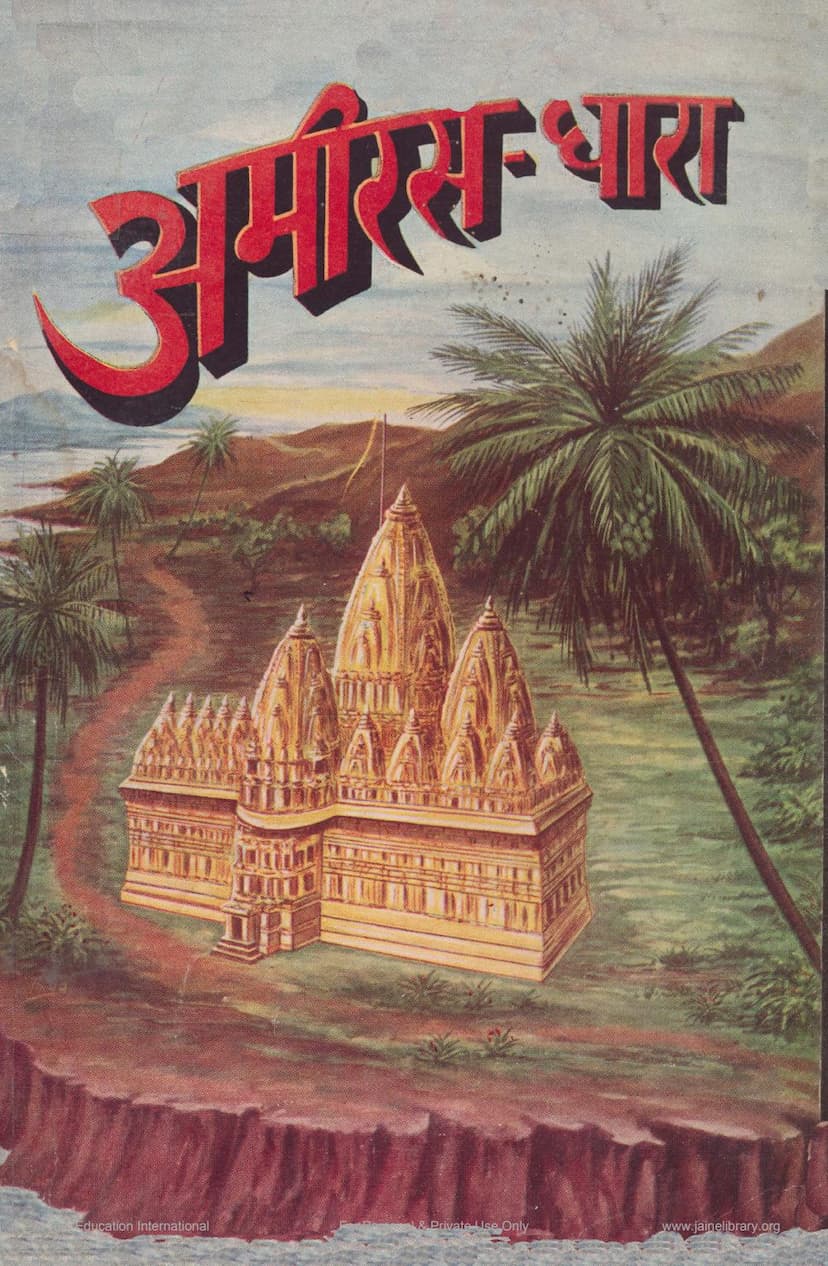Amiras Dhara
Added to library: September 1, 2025

Summary
The provided text is an excerpt from the Jain book "Amiras Dhara" (अमीरस-धारा), authored by Mahopadhyay Chandraprabh Sagar. The book was published by Jityasha Foundation in March 1988. The excerpt primarily focuses on the concept of "Jinatva" (जिनत्व), which can be translated as the state of being a conqueror, specifically a spiritual conqueror of one's own self.
Here's a summary of the key themes and arguments presented in the excerpt:
1. The Journey from Ganga Sagar to Gangotri: A Metaphor for Spiritual Pursuit:
- The text uses the metaphor of the Ganga river's journey from its source (Gangotri) to the ocean (Ganga Sagar) and back to Gangotri via evaporation and rain.
- Vedic/Brahmanical Culture: This is likened to the Ganga flowing downstream, representing the outward journey, expansion, and merging with the universal flow (like flowing with desires, surrendering to a higher power, and the Vedic concept of "Aham Brahmasmi" - I am Brahman). This is seen as a natural flow, easy but incomplete.
- Jain Culture: This is presented as the reverse journey, from Ganga Sagar back to Gangotri. It signifies returning to one's origin, drawing back one's senses, and self-containment. This is described as a difficult but ultimately complete and true spiritual path, the path of "Jinatva."
2. The Nature of "Jinatva":
- Self-Conquest: "Jinatva" is not about conquering external enemies but about conquering one's own inner enemies – desires, passions (kashayas), senses, and the fragmented mind ("bahuchittavan").
- Effort and Struggle (Purusharth): The path to "Jinatva" is a path of struggle, effort, and striving against the natural flow of desires and worldly attractions. It requires immense courage, determination, and perseverance.
- Contrast with Devotion (Bhakti): While devotion is a path of surrender, "Jinatva" is a path of self-reliance, valor, and strenuous effort.
- The Kshatriya Connection: The text highlights that all 24 Tirthankaras were Kshatriyas, suggesting a natural affinity between the Kshatriya spirit of valor, resolve, and struggle and the path of "Jinatva." However, it clarifies that "Jinatva" is not exclusive to any caste but is achieved through spiritual effort and self-mastery.
- Inner Strength: True strength lies in self-control and conquering oneself, not in external warfare. The text quotes the saying: "He who conquers thousands of enemies in battle is less than he who conquers himself."
3. The Meaning of "Jina" and "Jain":
- Jina: A "Jina" is a spiritual conqueror, someone who has achieved self-mastery and conquered their inner enemies. This state is achieved through rigorous practice and effort.
- Jain: A "Jain" is an follower or devotee of a Jina. While respecting and worshipping the Jina is important, it is not the same as becoming a Jina oneself. Blind adherence to tradition or a Jina without personal effort is seen as a hindrance to achieving "Jinatva."
4. Key Principles for Achieving "Jinatva":
- Self-Reliance: Do not blindly follow others; develop the courage to stand on your own feet.
- Critical Inquiry: Use logic and reason to understand truth, rather than accepting things on blind faith.
- Inner Focus: Turn your attention inward; the "light" and the "treasure" are within you, like the musk deer searching for musk in the forest.
- Integrity of Thought, Word, and Deed: Align your thoughts, speech, and actions.
- Discernment: Differentiate between true and false desires, between genuine spiritual practices and mere external rituals.
- The Importance of Effort: Nothing valuable is achieved without effort and sacrifice. The path of "Jinatva" is like the "Asidhhara" (sword's edge) – difficult but rewarding.
5. The Concept of "Ajina" (अजिन):
- The text contrasts the path of "Jinatva" with the path of "Ajina."
- "Ajina": Represents external focus, materialistic pursuits, sensory indulgence, and a superficial worldview. It's likened to the Charvaka philosophy of "eat, drink, and be merry."
- Consequences of "Ajina": Following the "Ajina" path leads to a lack of true understanding, attachment to the material world, and ultimately, spiritual emptiness.
6. The Significance of "Jina" in Jainism:
- "Jina" is the root and essence of Jainism. Without understanding the "Jina," the follower (Jain) is meaningless.
- The word "Jina" itself is deconstructed to reveal its profound meaning: "Ja" (जय - victory), "I" (इन्द्रियाँ - senses, desires), and "Na" (negation). Thus, "Jina" means one who has conquered their senses and desires.
7. The Four Varnas and "Jinatva":
- The text briefly touches upon the four varnas (Brahmin, Kshatriya, Vaishya, Shudra) and their roles in spiritual pursuit. It emphasizes that "Jinatva" is achievable by anyone, regardless of their social standing, through dedicated spiritual practice. Mahavir himself is portrayed as embodying both Brahminical wisdom and Kshatriya valor.
Overall Message:
The excerpt from "Amiras Dhara" strongly advocates for a path of self-mastery and spiritual conquest through rigorous personal effort, self-discipline, and introspection. It presents "Jinatva" as the ultimate goal of human life, achievable by turning inwards and overcoming one's internal weaknesses, rather than seeking external validation or salvation. The metaphor of the Ganga's journey effectively illustrates the difference between a superficial outward journey and the profound inward journey of self-realization.